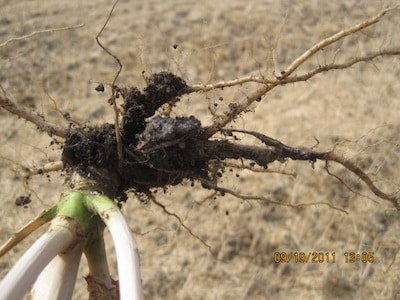Example of clubroot galls found at harvest time.
Discovery of a different clubroot pathotype in central Alberta will change the rotation plans for some growers. No current varieties have resistance to this different pathotype, and varieties with a new effective source of resistance will not be available for at least the next year or two, or maybe longer. Longer rotation is necessary to slow the pathogen shift that is occurring in these fields. Other management measures, including weed/volunteer control, tillage reduction and sanitation, are also necessary to slow the buildup and spread of this pathotype.

If growers have used resistant canola two or three times already on fields that were infested with clubroot, these fields are at high risk for having this different pathotype. Any fields that have had heavy clubroot infestation are at high risk for pathogen shift to overcome resistance. Longer breaks between canola crops is the best management option on those fields. Do not plan a tight rotation on these fields, as you cannot count on new resistance being available in time.
Source: Alberta Canola Producers Commission